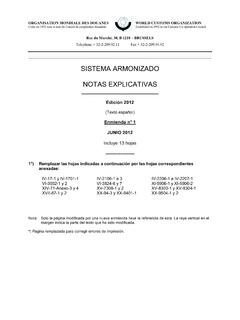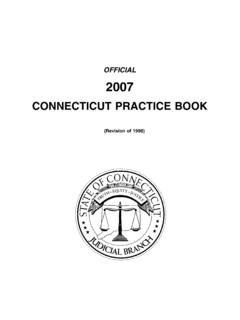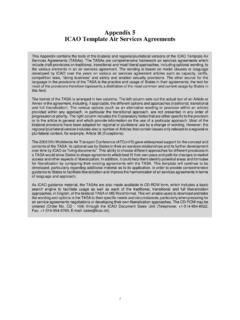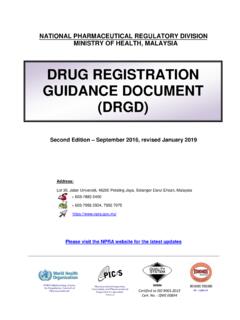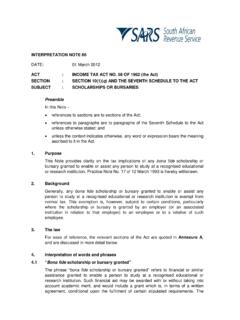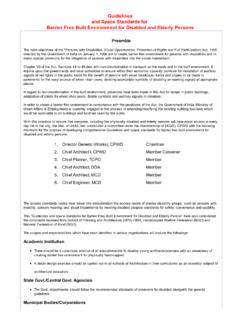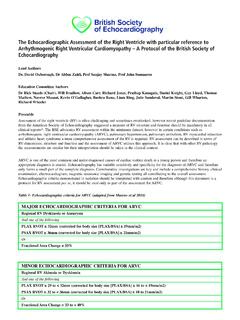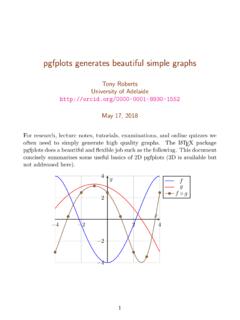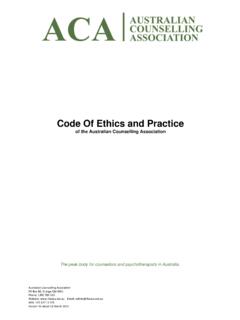Transcription of HS CLASSIFICATION HANDBOOK
1 HS CLASSIFICATION HANDBOOK WORLD CUSTOMS ORGANIZATION Rue du March 30, B-1210 Brussels Telephone + Fax + November 2013 The Customs Co-operation Council* ( ) was established by a Convention signed in Brussels on 15th December 1950. Under the terms of that Convention, the functions of the Council are: (a) To study all questions relating to co-operation in customs matters. (b) To examine the technical aspects, as well as the economic factors related thereto, of customs systems with a view to proposing to its Members practical means of attaining the highest possible degree of harmony and uniformity. (c) To prepare draft Conventions and amendments to Conventions and to recommend their adoption by interested Governments. (d) To make recommendations to ensure the uniform interpretation and application of the Conventions concluded as a result of its work as well as those concerning the Nomenclature for the CLASSIFICATION of Goods in Customs Tariffs and the Valuation of Goods for Customs Purposes and, to this end, to perform such functions as may be expressly assigned to it in those Conventions in accordance with the provisions thereof.
2 (e) To make recommendations, in a conciliatory capacity, for the settlement of disputes concerning the interpretation or application of the Conventions referred to in paragraph (d) above. (f) To ensure the circulation of information regarding customs regulations and procedures. (g) On its own initiative or on request, to furnish to interested Governments information or advice on customs matters within the general purposes of the present Convention and to make recommendations thereon. (h) To co-operate with other inter-governmental organisations as regards matters within its competence. The Council possesses juridical personality. * In June 1994 the Council adopted the informal working name World Customs Organization (WCO) for the Customs Co-operation Council, in order to indicate more clearly its nature and world-wide status. The Convention establishing the Organization has not been amended, and Customs Co-operation Council remains the official name.
3 Copyright 2013 World Customs Organization (established in 1952 as the Customs Co-operation Council)All rights reserved. Any request regarding translation, reproduction and adaptation of this document should be addressed to D/2013/0448/14 ISBN : 978-2-87492-136-0 (i) Pages FOREWORD .. (ix) Part I: INTRODUCTION I Part II: THE HARMONIZED SYSTEM (HS) II/1 Chapter 1 Implementation of the HS .. II/1 Chapter 2 Description of the HS .. II/3 1. General .. II/3 (a) Multipurpose Nomenclature .. II/3 (b) Structured Nomenclature .. II/4 2. Structure of the HS .. II/5 (a) The Interpretative Rules .. II/5 (b) Section and Chapter Notes, including subheading Notes .. II/7 (c) Headings and subheadings of the II/8 3. The relationship between the HS Nomenclature and the complementary publications and data bases .. II/11 (a) Explanatory Notes .. II/11 (b) Compendium of CLASSIFICATION Opinions .. II/11 (c) Alphabetical Index.
4 II/12 (d) HS Database online .. II/12 (e) Correlation Tables .. II/12 (f) E-learning: Courses via Internet technology .. II/13 (g) Correlation between the product coverage of selected international conventions and the Harmonized System .. II/14 (h) CLASSIFICATION Decisions taken by the Harmonized System Committee from the 1st to 26th and from the 27th to 46th Sessions .. II/14 Chapter 3 Commentary on the Harmonized System Convention .. II/16 1. General .. II/16 2. Preamble .. II/16 3. Articles of the II/16 Chapter 4 HS and National Customs Tariffs .. II/27 Chapter 5 HS and Trade Statistics .. II/28 1. National trade statistics .. II/28 2. WCO Recommendations concerning trade statistics .. II/29 Chapter 6 Working languages of the Harmonized System .. II/30 (ii) Part III: MAIN ELEMENTS OF A GOOD TARIFF CLASSIFICATION WORK MODEL III/1 Chapter 1 Introduction .. III/1 Chapter 2 Main Elements of a Good Tariff CLASSIFICATION Work Model.
5 III/2 Chapter 3 CLASSIFICATION Infrastructure .. III/6 1. General .. III/6 2. Headquarters: CLASSIFICATION Committee and CLASSIFICATION Centre .. III/6 3. Regional or Local CLASSIFICATION Offices .. III/8 Chapter 4 CLASSIFICATION Procedure .. III/9 1. General .. III/9 2. Pre-entry stage CLASSIFICATION .. III/9 3. Declaration-processing stage CLASSIFICATION .. III/13 4. Post-clearance stage CLASSIFICATION .. III/13 Chapter 5 Dispute Settlement .. III/14 1. General .. III/14 2. Informal procedure: Consultation with importers and exporters .. III/14 3. Formal III/15 Chapter 6 HS Capacity Building and Other Matters .. III/16 1. Training .. III/16 2. Integrity .. III/17 3. Publishing information .. III/18 4. HS Capacity Building .. III/18 Chapter 7 The Role of Customs Laboratories .. III/19 Chapter 8 Implementation by Administrations of the Recommendation on the Introduction of Programmes for Binding Pre-entry CLASSIFICATION Information.
6 III/211. Legal basis .. III/21 2. Procedure for obtaining binding information .. III/22 (a) The requesting party .. III/23 (b) Request III/23 (c) Notification of the information to the applicant .. III/24 3. Legal effect of the ruling III/25 4. Procedure for appealing against binding information rulings .. III/26 5. Statistical data .. III/27 Part IV: MAINTENANCE OF THE SYSTEM: HS COMMITTEE AND SUB-COMMITTEES IV/1 Chapter 1 Harmonized System Committee (HSC) .. IV/1 1. Establishment of the Committee .. IV/1 (iii) 2. Role of the Committee .. IV/2 (a) Ensuring the uniform interpretation and application of the IV/2 (b) Settlement of disputes between Contracting Parties with regard to the CLASSIFICATION of goods in the HS .. IV/3 (c) Continuous updating of the HS, taking into account the changes in technology or in patterns of international trade .. IV/3 3. Questions Handled and Form of Decisions Taken by the Committee.
7 IV/4 (a) Technical questions .. IV/4 (b) General questions .. IV/5 Chapter 2 Sub-Committees and Working Parties .. IV/7 1. The HS Review Sub-Committee (RSC) .. IV/7 2. The Scientific Sub-Committee (SSC) .. IV/7 3. Working Parties .. IV/8 Part V: HS-RELATED WCO RECOMMENDATIONS V/1 Chapter 1 General .. V/1 1. Introduction .. V/1 2. Nature and purpose of HS-related Recommendations .. V/1 (a) What is an HS-related Recommendation? .. V/1 (b) Why are Recommendations needed? .. V/2 (c) Legal scope of HS-related Recommendations .. V/2 (d) Implementation at national level .. V/2 Chapter 2 Recommendations Concerning Insertion of Subdivisions in National Statistical Nomenclatures .. V/4 1. Ozone Layer Depleting Substances (Annex ) .. V/4 2. Chemical Weapons (Annex ) .. V/5 3. Hand-made products (Annex ) .. V/5 4. Products specified in the Protocol concerning firearms covered by the UN convention against transnational organized crime (Annex ).
8 V/6 Chapter 3 Recommendations Concerning the Uniform Interpretation and Application of the HS .. V/7 1. Pre-entry CLASSIFICATION Programme (Annex ) .. V/7 2. Good CLASSIFICATION Work Model (Annex ) .. V/7 3. Standard Units of Quantity (Annex ) .. V/8 4. Reporting trade statistics to the United Nations (Annex ) .. V/10 5. Application of HS Committee Decisions (Annex ) .. V/10 Chapter 4 Resolution on the Insertion in Commercial Invoices of the Code Number for the CLASSIFICATION of Goods in the Harmonized Commodity Description and Coding System (Annex G) .. V/11 Part VI: INFORMATION CONCERNING HS USERS VI/1 Chapter 1 Customs Laboratories of Member Administrations .. VI/1 (iv) Chapter 2 Application of Chapters 98 and 99 .. VI/3 1. General .. VI/3 2. Users of Chapters 98 and 99 .. VI/3 Chapter 3 Application of the HS in Areas Other than Customs Tariffs and Trade Statistics .. VI/12 1. Government users .. VI/12 2.
9 International organizations .. VI/13 3. Private sector .. VI/13 Chapter 4 Annual Survey Concerning Percentage of National Revenues Represented by Customs Duties .. VI/14 Chapter 5 HS Data Bases and Web Sites .. VI/15 Chapter 6 HS Contact Points .. VI/16 Chapter 7 The HS and Social and Environmental Concerns .. VI/17 Chapter 8 Information Available on the WCO Web Site .. VI/19 1. Nomenclature and CLASSIFICATION of goods .. VI/19 Overview .. VI/19 Activities and programmes .. VI/19 Tools and instruments .. VI/20 Resources .. VI/22 2. VI/23 3. Meetings .. VI/23 Harmonized System Committee .. VI/23 HS Review Sub-Committee .. VI/24 Scientific Sub-Committee .. VI/24 (v) Annex A Objectives of the the Harmonized System .. A/1 1. Development of international goods nomenclatures .. A/1 2. Relations between the HS, CCCN and SITC .. A/3 (a) Customs Co-operation Council Nomenclature (CCCN) .. A/3 (b) Standard International Trade CLASSIFICATION (SITC).
10 A/4 (c) Correlation between international trade statistical nomenclatures and international customs tariff nomenclatures .. A/4 3. Origin of the Harmonized System .. A/5 4. Development of the Harmonized System .. A/6 (a) Exploratory phase .. A/6 (b) Preparatory work .. A/7 (c) Repercussions of the Harmonized System preparatory on the CCCN and the SITC .. A/10 Appendix 1 List of participants in the study group .. Appendix 2 List of participants in the Harmonized System Committee and its working party .. B International Convention on the Harmonized Commodity Description and Coding System (14 June 1983) and Protocol of Amendments to the Convention (24 June 1986) .. B/1 Protocol of amendment to the international Convention on the Harmonized Commodity Description and Coding B/11 Annex Rules of Procedure of the Harmonized System Committee .. Chapter I Composition and functions .. Chapter II Representation .. Chapter III Committee meetings.


